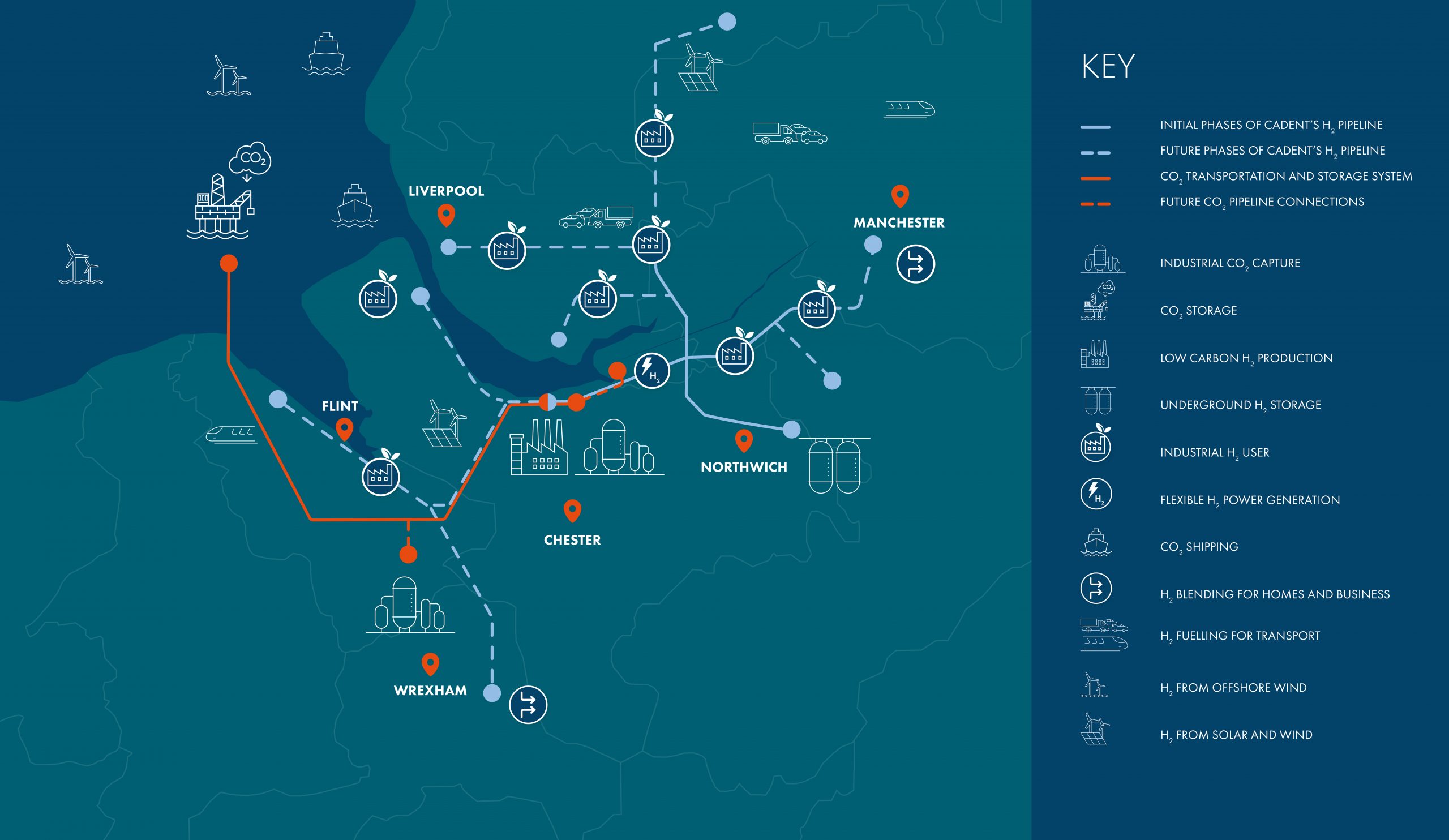The deal paved the way for the HyNet project to develop green technologies that are expected to create 6,000 jobs across North West England and North Wales. The project will, once established, provide almost 50% of the hydrogen needed to meet the UK’s net zero targets.
Deirdre Michie, chief executive of Offshore Energies UK, leading trade body for the UK’s integrating offshore energies industry and one of the architects of the deal, said the one-year assessment suggested the deal would generate up to £16 billion in private sector investments, reduce CO2 emissions by 60 million tonnes and generate 40,000 new jobs. The regions chosen to develop the first technology clusters will be among the biggest beneficiaries.

HyNet will extract natural gas from Liverpool Bay and turn it into hydrogen at Stanlow Refinery. The hydrogen will then by directed to local factories via a pipe network. The project will also use carbon-capture technologies to store the CO2 generated during the process in depleted gas reservoirs deep under the seabed in Liverpool Bay. About two million tonnes of would be locked away each year by 2030.
Deirdre Michie:
“If we can clean up our own natural gas by turning it into hydrogen, and permanently storing the waste CO2, then the North Sea can become a secure source of low-carbon energy from gas. That’s in addition to the huge success of offshore wind which is set to quadruple by 2030 and which is proving a huge national success.
“I want to thank and support the people and businesses for their commitment to developing these technologies. Just one year after signing the North Sea Transition Deal, a greener future is beginning to take shape for the UK.”

The UK Government has said mass production of hydrogen is central to its net zero strategy. The UK Government’s Hydrogen Strategy suggests the gas could supply 20-35% of the UK’s final energy consumption by 2050.
HyNet North West is one of three UK projects pioneering similar technologies for the mass production of clean-burning hydrogen from natural gas with carbon capture and storage, alongside Zero Carbon Humber, on the North East coast of England, and Acorn, based in Aberdeenshire.
_____________________________________________________________________________________________________________________________
What is hydrogen fuel?
What is hydrogen?
Hydrogen is one of the most abundant elements on earth, almost all of it locked into compounds such as water (H2O) and natural gas (CH4). For use as a fuel, it first has to be extracted from those compounds.
Why are we using hydrogen?
Like natural gas, hydrogen releases a lot of energy when burnt. Unlike natural gas, it produces no CO2 so it has no climate impacts. It’s also very ‘energy-dense’ meaning a small volume contains a lot of energy. This makes it idea for powering heavy vehicles such as lorries and buses. Nasa uses it as a rocket fuel for the same reason. Hydrogen can also be stored which can help balance supply and demand.
How can we make hydrogen?
Natural gas is made of methane molecules which comprise four hydrogen atoms attached to a single carbon atom (CH4). These molecules can be broken down by reacting them with superheated steam. This releases pure hydrogen plus CO2. Hydrogen will also eventually be produced by splitting water through electrolysis but production using gas is the natural stepping stone to achieve scale as the new energy source is developed and rolled out.
Why do we need to capture CO2?
Carbon dioxide (CO2) emissions cause climate change so reducing them is essential. The UK Government’s net zero emissions target means that by mid-century our overall emissions should have been cut to nothing.
Where will we capture it?
Industrial processes like power generation or chemical manufacture emit huge amounts of CO2. We can reduce this by switching to low-carbon fuels such hydrogen, or by directly capturing the emissions via a process known as Carbon Capture and Storage (CCS).
How does Carbon Capture and Storage (CCS) work?
When natural gas or any other fuel is burnt it produces CO2 which can be captured using chemical processes. The CO2 is then compressed so that it can be transported via a pipeline. The CO2 is subsequently stored underground in carefully selected offshore sites.
Can we be sure the CO2 won’t escape?
Natural gas has remained safely trapped in geological structures such as sandstone reservoirs for millions of years. These reservoirs are typically hundreds of metres below the seabed with impermeable layers above that trap the gas in place. The CO2 will be stored in depleted reservoirs in the same way as the original natural gas. It will remain safely contained in the sandstone reservoirs.
How will the industry be monitored?
Oil and gas operators must operate to the highest safety standards. Infrastructure and operations will be strictly regulated by the UK Government’s Oil and Gas Authority (OGA) and Offshore Petroleum Regulator for Environment and Decommissioning (OPRED).






